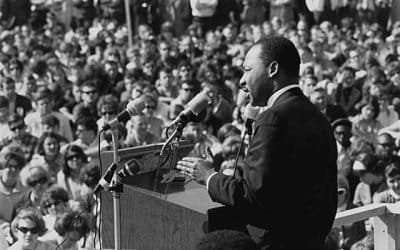As with many inventions, Elisha Otis’s creation proved to have a much more far-reaching affect than just the need it was immediately designed to serve.
On April 1, Otis Elevators celebrated its 150th anniversary. Appropriately, it was in New York City that Elisha first demonstrated his invention, an 18-foot-tall hoist to which he added an automatic safety device for the platform. Initially, the elevator was used for industrial purposes, but by 1857 E.V. Haughwout and Co. department store in Manhattan had installed one for passengers.
The elevator’s most significant affect, however, is how it helped transform architecture. Along with the steel girder, the elevator made possible a unique and distinctly American architecture: the skyscraper. The skylines of cities were dramatically redesigned, as stately buildings soaring ever higher were erected and stood as proud boasts of American ingenuity.
While architects such as Louis Henri Sullivan gave birth to the skyscraper in Chicago, families of this new structure were raised primarily as tall office buildings in New York. In 1880, the 284-foot spire of the Trinity Church remained Manhattan’s tallest structure. Not until 12 years later did the 309-foot-tall Pulitzer Building overshadow it. Thereafter, “to bring business that dealt with one another close together, and to fit them into the congested downtown, New York builders began to build tall,” writes Daniel Boorstin in “The Creators.”
Thus, it was capitalism that pushed skyscrapers progressively higher. In 1913, merchant Frank Woolworth constructed a 792-foot-tall building bearing his name and was dubbed the “cathedral of commerce.” Two year later, the Equitable Life Building, with its 39 stories and 1.2 million feet of space, became the world’s largest office building. When completed in 1930, the Chrysler Building, standing 77 stories and featuring high-speed elevators, was the world’s tallest skyscraper for less than a year. Just a few months later, the 102-story Empire State Building was built. But the EPS would remain New York’s tallest building until the early 1970s, when the Word Trade Center’s 110-storied twin towers were erected.
In “The Creators,” Boorstin is half-correct when he describes the skyscraper’s symbolic meaning: “its gesture was not to the gods, nor to God, but simply to the sky.” The skyscraper’s gesture, however, is not merely to the sky,” but to the earth’s greatest, boundless natural resource — man’s rational mind.
The skyscraper is unique and distinctly American because it embodies this nation’s unprecedented freedom and emphasis on reason. For centuries men were forced to either sacrifice their minds and actions to God’s commands, or face charges of heresy and burning at the stake. In the New World, the individual was finally free to think and act independently, and his inborn right to keep the products of this thought and actions were upheld. The result was a new man, an American, an unchained, innovative individual who reshaped the earth according to his values. Under free trade, the businessman exponentially increased his capital, expanded his company, created new ones and hired increasingly more workers, all of which sparked his need for more office space. Thanks to the individuals who reshaped earth’s natural resources into steel girders and elevators, the businessman no longer needed stretches of land to build on, but looked instead to the limitless sky to take on the soaring creations of his productive mind.
The skyscraper’s true symbolic gesture is captured best by philosopher Leonard Peikoff, when he said of his associate Ayn Rand, author of The Fountainhead: “New York, the skyscrapers, everything that man had traversed from the time of the cave to the time of this glorious and industrial civilization, that was to [her the pinnacle of human achievement in physical terms.] It wasn’t just acquiring philosophy. It was acquiring ideas, acquiring science and then remaking the earth accordingly. And she couldn’t think of a more splendid and exciting and beautiful place than that view that you get of the skyscrapers when you don’t see the details of each one, but the mass of ingenuity and talent soaring for the sky.”
Today, the Ayn Rand Institute carries on this sublime vision of the novelist/philosopher. One example is a project ARI and its associates instituted, the National Campaign in Defense of Industry, which was specifically held each April 22 — Earth Day.
I continue to celebrate Industry Day on that date, of course, not to worship planet earth as mystics worship God, as something to bow down to and sacrifice your self-interests. No, I accept no guilt for chopping down trees to build my home, no penance for paving over a dirt road to drive my car across, no eternal damnation for mining ore to mold a girder to erect my office building. I value human life and happiness, whose foundation is not earth’s abundant resources, but man’s rational thought and initiative in reshaping them to further and better his life.
But environmentalist philosophy seeks the reverse. At root, environmentalism commands man to stand in reverence before Almighty Mother Nature and to either passively worship her for (allegedly) giving man her fruits, trees and other resources, or to leave her untouched. In essence, environmentalism demands that he sacrifice himself to the sub- or non-human and ultimately consign himself to misery and death.
That is why I celebrate individuals like Otis, who reshape nature according to man’s values and needs, who create labor- and time-saving creations such as the elevator, automobile, telephone, airplane, CAT scan machine, vacuum cleaner, refrigerator, television and computer, and who create the skyscrapers that serve as the creators’ workplace. It is the thinkers, inventors, entrepreneurs and businessmen who make human life and happiness possible, and it is they to whom we should all pay tribute each Industrial Day.



